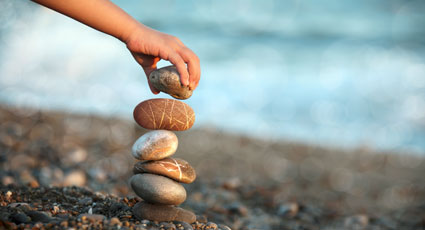INTRODUCTION
The Japanese culture prizes discipline, it's no coincidence then that Japanese style is known for minimalism, as a level of discipline is required to pull off a minimalist decor. Not only is there a constriction of objects in the room, but the scarcity of objects encourages a practice of ensuring those that remain in the room are well-made, tidy, and beautiful.
This article focuses on a minimalistic style inspired by Zen Buddhism, a religion centered on the idea of harmony. Keeping this in mind, the style relies heavily on balance to create harmony among the room's objects, fabrics, and textures, and within the broader world. Minimalist Japanese features elements inspired not only by nature, but an ever-changing nature. Finishing touches inspired by water, earth, wind and fire revolve just as the seasons change.
The natural, harmonious theme creates a straight-forward style dedicated to living necessities. It features plenty of geometric lines and clean shapes to move the eye gently around the room. With this basis in place, Minimalist Japanese can venture into underlying themes such as Wabi Sabi, samurai inspired, geisha influenced, or leaning towards a westernization of the concept. Keeping a possible range of minimalism in mind, lifestyle heavily dictates what rooms work best in Minimalist Japanese. Some people enjoy the full effect in dedicated yoga rooms or bathrooms, and others enjoy full minimalism in the living room and bedroom where relaxation improves without the noise of objects.
In this article you'll learn:
- Top color choices for achieving a Minimalist Japanese style
- Textures and fabrics most aligned with the decorating theme
- Finishing touches to consider utilizing
- Decluttering 101
- Developing a Aristocratic Japanese Fusion style
COLORS
It's no surprise the naturally inclined, simple style of Minimalist Japanese features neutral colors, specifically browns, whites, greens, and black. Use red as an accent very sparsely, to the point of one painting, a couple of vases, or throw pillows. Keep the elements of nature in mind when choosing colors (and objects). Attempt to represent each natural element equally: water, earth, wind, and fire.
TEXTURES AND FABRICS
When adding materials into a Minimalist Japanese style room remember to emphasize natural light and open space. Open space tends to be more affected by furniture, but natural light can be hindered with fabrics, such as shades. For this reason, keep windows bare with the exception of simple shades. Split cane shades work well for privacy and hindering natural light when necessary, a great functional and aesthetically pleasing material.
To balance the rough textures of the mentioned textures, use silk fabrics and rice paper screens. For a do-it-yourself project, construct a screen's frame from cedar then cover with rice paper or sheets of handmade paper. In addition to screens, the Japanese often hang light fabric in the doorways, called noren. The length of each noren either goes halfway or full length to sweep the floor. The idea with the screens and noren is to create an openness within the room, even when closed. The lighter materials achieve an openness aspect better than a heavy door or screen made from heavier material.
FURNITURE STYLES
When choosing furniture look for low sitting pieces with clean, geometric lines. The lines don't have to be all straight- balance the look with a few curves. Chairs often offer opportunities for desired subtle curvature. Again, natural material: teak, bamboo, cedar, and juniper wood. The furniture should have the appearance of being polished and emphasize the tidy, clean characteristic. Lacquerware tables help further promote the polished appearance. Some ideas for furniture pieces include:
- In the bedroom, consider a low platform bed without a box spring.
- A low dining room table with legless chairs. Options with backs are available for those with like to recline a bit when eating.
- Low coffee tables are easy to come by, but be sure the coffee tables matches a low couch and vice versa. The proportions will be unbalanced if these two are disproportionate.
Lower furniture isn't too difficult to come by, it's merely a matter of deciding how low you're willing to go. It's more important for the decor to be functional rather than perfectly representative of a decor style. If eating on legless chairs isn't for your family, then find a normal height dining room table with chairs that match the Minimalistic Japanese elements, just not as short.
FINISHING TOUCHES
Keep in mind the idea of sparseness for a Minimalist Japanese style room. The lack of decoration is considered a disciplined decorating style, but that doesn't mean underlying themes can't shine through in the few added elements.
For a basic Minimalist Japanese room, heavily inspired by Zen Buddhism, utilize:
- Paintings and silk tapestries on the wall. Cherry blossoms and lotus plants make excellent subjects for the artwork.
- Hang four nature-inspired paintings and rotate them with the seasons.
- Consider the four elements of nature: earth, wind, fire, and water when choosing items. Earth can be a collection of rocks, candles represent fire, a painting with gentle blue strokes can represent water, and a wind chime is a great symbol for wind.
- Use lantern style lamps and fixtures, completely paper or wooden framed with paper insets. Keep simplicity and practicality at the forefront when choosing lighting.
- Expansive views are important for this style, so be sure windows are large and unobstructed. The views become part of the decor.
- To represent a earthly appreciation, incorporate plants to symbolize growth and regeneration. Good options include palms, bonsai, and orchids.
- A beautiful Japanese tea set is both pleasant to look at and use.
Wabi Sabi is the the Japanese acknowledgement of imperfection and all the cycles of life, specifically death and decay. For a culture that values discipline and perfection, Wabi Sabi is a profound way of decorating and appreciating life's imperfections, it embraces things that are a bit rough around the edges. To include a Wabi Sabi theme, switch out the clean cut lacquered tables for rustic, well-worn versions. Add pots filled with dead branches and don't stress about chipping paint or mismatched dinnerware. This direction cancels out some of the previously discussed style elements, however it's important to understand both Minimalist Japanese and Wabi Sabi to decorate a room properly in those schemes. There's a thin line between Wabi Sabi and a decrepit mess, understanding the foundations will ensure that line isn't crossed.
Incorporating either a samurai theme or geisha theme involves utilizing the right elements. A samurai theme pays tribute to the disciplined Japanese warrior culture while a geisha theme acknowledges the multifaceted skills female Japanese entertainers acquired. Look for artwork featuring the subjects, to include actual weaponry or a beautiful silk wall hanging or umbrella. The themes not only pay tribute to aspects of Japanese culture, but direct a room towards masculine (samurai) or feminine (geisha) undertones. Keeping this in mind add elements aligned with the Minimalist Japanese style, but also include more masculine or feminine touches to play up the desired undertones.
Finally, when decorating in Minimalist Japanese, there is a decision of how "westernized" the room will be treated. It's not necessarily a theme, but rather a decision as to how far one would like to go with the minimalist aspect of the decor scheme. The traditional eastern style involves as little furniture and objects as possible, keeping wide spaces and scarcity main attributes. A home yoga or meditation room would benefit greatly from the lack of things and furniture, as well as the bathroom. In some cases the westernized route of a few more furniture pieces is necessary, such as a small apartment where closet space is limited so armoires and cabinets are necessities.
Another example of westernizing the style was mentioned previously regarding the height of dining room tables: if eating on the floor defeats functionality, opt for a more westernized height. When westernizing Minimalist Japanese, be sure to maintain as much open space as possible and keep items limited to necessities. It is greatly encouraged before any decorating project to clear out unnecessary clutter, regardless of the final style.
STYLE LESSON- DECLUTTERING 101
Decluttering is one of those activities that tends to be easier for some rather than others. What's worse, after years of collecting things, decluttering can become such a daunting task that it never gets started. It's time to start. Regardless of the decorating scheme chosen for a room, the decorating process needs to begin with decluttering.
When is the best time to declutter? After an initial cleansing, aim for annual if not seasonal shifting through of objects. If you practice good tidiness and elimination through the year, then annual decluttering won't take long at all.
What exactly are you doing when decluttering? First eliminate unnecessary items.
- Important documents should be shredded before being tossed. Know expiration dates, as for insurance paperwork, and items, like birth certificates, that never are thrown out. Then set up a personalized filing system. Add categories to files for organization and even arrange items by date. If anything can be digitalized, take the time to do that extra step, it'll save a lot of space. Be sure to back up scanned items on a secondary storage device.
- Clothing is possibly one of the most difficult areas to declutter due to the abundance and the resolution that "I'll lose ten pounds and fit in it again." For this reason, time clothing decluttering after summer, when you'll likely be in better shape versus the winter with its many holidays and comfort foods.
Items that you regularly wear don't have to tried on, but everything else needs a test try. Make four piles: toss, donate, tailor, keep. Anything stained or worn out is tossed. Items in good condition that don't fit are donated. This means if buttons can't be buttoned, breathing is difficult, or the item simply isn't flattering, it's being donated. This isn't the time to promise dieting or a foreseeable exercise regimen, or to rationalize that it's only been worn once. If it doesn't fit at the time of decluttering, it's out.
Items that fit but need hemming, new buttons, or holes stitched are placed in a tailor pile. After shifting through the entire closet take the items to a tailor or mend them at home. Finally, within items that pass inspection, make subcategories of t- shirts, long sleeve shirts, jeans, etc. Be sure the subcategories work for you. Place everything neatly into drawers and closets, and work on keeping the tidiness prevalent until the next decluttering.
- Furniture and trinkets tend to be easier categories to declutter. Furniture that is clearly broken beyond repair or worn down should be tossed. If anything can be repurposed, then do so. Everything else can be sold or donated.
Trinkets fall into the same categories: tossed, repurposed, or donated. However with trinkets people tend to add more sentimental value. If decluttering trinkets poses problems due to feelings then analyze if the items need to be gotten rid of for space purposes, and if so, go through them carefully, articulating exactly what sentiments they evoke. Be honest and you'll find some things aren't necessary valued as much as the memories behind them, in which case photos of the objects alongside written stories can save space and serve remembrance purposes.
After decluttering any area, think organization. Develop categories, utilize storage compartments and boxes. Do whatever works functionally to keep things tidy. The final step in decluttering requires not unravelling all that effort through the purchase of more unnecessary items. Of course this is quite personal, but two possible methods are:
- Patience Method- wait a week (or other personally designated timeline) before purchasing something. If your heart is still set on the item after a week, go for it.
- List method- keep various note pad lists (electronic tends to be easier) with each list geared towards various areas of the home (kitchenware, decor wants, clothing wants). Save desired items on the appropriate list. When shopping in one of the stores driven by a list, buy only what is on the list. This method decreases impulse purchases and even works in a similar fashion as the Patience Method. Sometimes enough time passes, dissolving the desire to buy an item.
Regardless of the timing of decluttering, the organization techniques applied for decluttering and the method to avoid unnecessary purchases, practicing these steps regularly will keep your home filled with only functional and beloved objects.
SURPRISING FIT- ARISTOCRATIC JAPANESE FUSION
Additionally, unlike a traditional Aristocratic style room, this minimalist version should have less fabrics. Therefore choose fabrics with both styles in mind: the Aristocratic love of patterns and various fabrics, with the Japanese natural and clean composition. Keep windows simple, but choose chairs with beautiful silk fabric depicting cherry blossoms. Furniture can be a mesh of both styles, so aim for either straight, clean lines with Aristocratic influenced fabric, or vice versa.
SUMMARY
Minimalist Japanese style requires a level of discipline to achieve, namely in eliminating excess objects within a room and promoting a sense of harmony with what remains. The ideal result is clean, simple, spacious, and pays homage to nature, making it well worth the decluttering efforts.
Combine Minimalist Japanese with underlying themes such as Wabi Sabi and samurai for more personality within a room. If full Minimalist Japanese doesn't work functionally, don't hesitate to westernize the style with higher furniture and more items within the room. Remember, a room's functionality is top priority.
Even if decorating in another style, decluttering is key in the designing process. It improves functionality within a room and within one's life. Develop personal methods of decluttering and how to avoid acquiring more unnecessary objects to keep a tidy, organized home and life.
Key elements for achieving a Minimalist Japanese style:
- Theme: Straightforward, clean cut, practical, with hints of discipline, and a respect for nature and space.
- Color: Look for neutral colors, specifically browns, whites, greens, and black.
- Textures and fabrics: Keep in mind nature and spaciousness. For textural materials look for split cane, bamboo, cedar and juniper wood, as well as dried grass and seaweed cloth, and reed mats with black borders. Balance the rough textures with silk fabrics and rice paper.
- Furniture style: Look for low sitting pieces with clean, geometric lines. A few curves can add balance and interest.
- Objects to pull it together: Try to incorporate objects representative of the four earth elements while at the same time being sparse in decor. Take the style a personalized route by adding elements representative of Wabi Sabi, samurai inspired, or geisha influenced.
Words of caution:
- Don't be afraid to westernize Minimalist Japanese with larger or more furniture. Functionality is more important that remaining absolutely true to the style.
- Avoid covering windows as views play an important role in the decor. Having a tucked away shade option, like split cane, will work to block the afternoon sun's glares on a TV or computer screen.
- When combining two opposite styles, it's sometimes easier not to meld the two exactly, but rather decorate with one style in mind then add enough elements of the other style to make it purposeful.

























